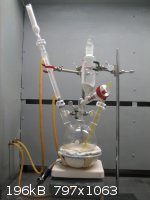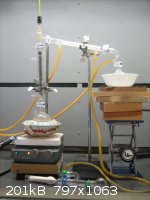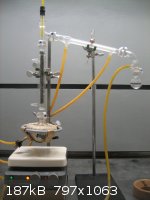Magpie
lab constructor
    
Posts: 5939
Registered: 1-11-2003
Location: USA
Member Is Offline
Mood: Chemistry: the subtle science.
|
|
Preparation of Methyl Borate
by Magpie
5/27/11
I. Introduction
This procedure describes the preparation of methyl borate, B(OMe)3, from methanol and boric oxide, B2O3. Preliminarily, the B2O3 is prepared from
boric acid, H3BO3. The theoretical yield is 84.0g of B(OMe)3 based on 50g of H3BO3. Although the %yield was not determined due to extracurricular
experimentation, it is estimated that it will be from 50 – 90%, depending on the lab technique and skills of the chemist.
II. Safety Advisement
Methyl borate, and especially methanol, are toxic and flammable. This procedure is to be done in a fume hood or outside.
III. Chemicals Required
A. Essential Chemicals
50g of boric acid (pottery grade is adequate)
183mL of methanol (gasoline deicer is adequate)
con sulfuric acid
B. Chemicals Not Strictly Required but Highly Recommended
CaCl2 desiccant spheres
compressed dried air, Ar, or N2
IV. Equipment Required
A. For Preparing B2O3
stainless steel crucible (~8cm dia x 4cm high with smooth inner surfaces)
Meker burner (or Bunsen burner, hotplate, etc, capable of strong heating)
ring stand with ring
clay triangle
steel tongs
ice-water bath
½” wood chisel or similar implement
mortar & pestle
capped bottle
B. For Preparing B(OMe)3
3-neck RBF, 500 or 1000mL
500mL RBF (optional)
250mL RBF
100mL RBF
electric heating mantle
powder feeder (if available)
Liebig or West condenser
Hempel column (20cm or longer preferred)
stainless steel scrub pad
still head
vacuum adapter
thermometer adapter
thermometer
250 mL separatory funnel
magnetic stirrer
magnetic stir bar
cartridge for CaCl2 desiccant spheres
V. Preparation of Boric Oxide, B2O3
(reference 1)
2H3BO3 --> B2O3 + 3H2O
1. Place 50g of boric acid in the stainless steel crucible.
2. Place the crucible on the clay triangle supported by the ringstand.
3. Apply strong heating with the Meker burner until the steam vapors are no longer evolving.
4. Using the tongs, immediately place the hot crucible in the ice-water bath to fracture the B2O3 into flakes, being careful not to get any water
inside the crucible.
5. Remove the flakes from the crucible and place in the mortar. Use the wood chisel as required in removing the flakes, but try not to gouge the
inside walls of the crucible.
6. Grind the flakes in the mortar to the mesh of beach sand.
7. The yield should be ~24g of B2O3.
8. Store the B2O3 in a capped bottle.
VI. Preparation of Methyl Borate, B(OMe)3
A. Conduct the Reaction
B2O3 + 6MeOH --> 2B(OMe)3 + 3H2O
Use all means practical to exclude water from the reactants and products as water will reduce yield as follows:
B(OMe)3 + 3H2O --> H3BO3 + 3MeOH
When this occurs it will be evident by the appearance of H3BO3, a white solid.
1. Secure the 3-neck RBF on a heating mantle supported by a ringstand.
2. Place a magnetic stirrer under the heating mantle.
3. Add a stirbar to the RBF.
4. Install the powder feeder, if available, in the center neck.
5. Install an ice-water cooled reflux condenser with CaCl2 cartridge in a side neck of the RBF.
6. Install a thermometer in the remaining side neck
7. Plug the center port if open.
8. Open the center port temporarily and add 183mL of methanol.
9. Add 23.9g of B2O3 to the powder feeder, or have it available for spoon feeding.
10. Flush the system with a dry gas (air, Ar, N2, or other suitably inert gas).
11. Turn on the magnetic stirrer.
12. Set the heating mantle to ~ 45% and heat the methanol up to 60C (bp = 64.7C).
13. Add the B2O3 powder in small amounts at a time noting the vigorous reaction with the methanol.
14. Due to the exothermic heat of reaction, it may be possible (or necessary) to reduce the amount of auxiliary heating.
15. When all of the B2O3 has been added continue to heat the reactants for another hour at a gentle reflux.
B. Obtain the Azeotrope by Fractional Distillation
The products of the reaction will now be fractionated to separate the azeotrope from the residual methanol. The azeotrope is 75.5% B(OMe)3/24.5%
methanol and has a bp of 54.6C. The reactor RBF may be used as the pot if convenient. Or the reactants may be transferred to a 500mL RBF pot, if
desired. If a transfer is made the new pot should be pre-flushed with dry gas and kept stoppered until in use.
1. Set up for fractionation using a Hempel column packed with a stainless steel scrub pad.
2. Install a thermometer at the stillhead as usual.
3. Install a 250mL RBF as receiver.
4. Install a heating mantle and magnetic stirrer as before.
5. Install an ice-water cooled condenser and vacuum adapter, as usual.
6. Attach a CaCl2 cartridge to the vacuum adapter vent using rubber tubing and other glassware adapters as required. See picture below.
7. Pre-flush set-up with dry gas.
8. Initially set the heating mantle power at 50%. Trim the heat as necessary to get a reflux ratio of at least 2:1. The azeotrope should come over
at exactly 54.6C. If the temperature exceeds this you are pushing the column too hard. Back off on the heat somewhat. Production rate should be ~
1drop/s.
9. Continue the fractionation until the bp starts to rise permanently above 54.6C.
C. Extract the Methanol from the Azeotrope
1. Place the azeotrope in a separatory funnel pre-flushed with dry gas, and stoppered.
2. Wash with con sulfuric added in the volumetric ratio 2:100, acid:azeotrope. Be sure to vent as required.
3. Drain off the lower phase as waste.
4. Wash 4 more times with acid in the volumetric ratio 0.8:100, acid:azeotrope based on the original volume of the azeotrope, draining off the lower
phase each time, as before.
D. Fractionally Distill to Isolate the B(OMe)3
This is required to remove any residual azeotrope, which will come off first as its bp is 54.6C and that of the B(OMe)3 is 68.7C.
1. Set up for fractional distillation as before, using the appropriate sized pot and receiver.
2. Remember to pre-flush the setup and all vessels with dry gas, and install the CaCl2 cartridge on the vacuum adapter vent.
3. Once the azeotrope has come off as a pre-run and the boiling point has risen to ~68.7C, change receivers to isolate the pure B(OMe)3.
VII. Discussion
The mole ratio of methanol:boric oxide is 12:1. This is twice that required by stoichiometry. This ratio was used to give full utilization of the
boron as indicated in reference 3.
All the effort put into keeping the reactants and products anhydrous may seem tedious. I found out the hard way the consequence of not keeping
everything scrupulously dry. I can’t quantify the %yield lost due to the formation of H3BO3 but it was visibly being formed often. By keeping
everything dry the products and glassware stay crystal clear.
NaCl was tried for breaking the azeotrope per reference 3 but it failed to form 2 phases. Possibly the anhydrous LiCl would have worked as the
authors explicitly stated that 2 phases were formed with this salt. But who has that salt. 4A molecular sieves were also tried for the absorbtion of
methanol but this also failed. Since the azeotrope is “positive,” the different molecules should have less affinity for each other than do the
pure components. So it seems that the methanol should not have had any trouble escaping into the “cages” of the mole sieves.
VIII. References
1. Post of garage chemist for preparation of B2O3: http://www.sciencemadness.org/talk/viewthread.php?tid=10778#...
2. JACS, August 1933, “Preparation and Purification of Methyl Borate and Ethyl Borate,” Webster & Dennis, pp 3233-3235.
3. JACS, March 17, 1952, “Procedures for the Preparation of Methyl Borate,” Schlesinger et al.
  
[Edited on 28-5-2011 by Magpie]
[Edited on 28-5-2011 by Magpie]
[Edited on 28-5-2011 by Magpie]
[Edited on 30-5-2011 by Magpie]
The single most important condition for a successful synthesis is good mixing - Nicodem
|
|
|
benzylchloride1
Hazard to Others
  
Posts: 299
Registered: 16-3-2007
Member Is Offline
Mood: Pushing the envelope of synthetic chemistry in one's basement
|
|
Do you have any plans for further syntheses involving methyl borate. If you can make phenylmagnesium bromide from bromobenzene, this can be reacted
with methyl borate at low temperatures to form benzene boronic acid. The large scale synthesis of this compound is described in Organic Syntheses.
Phenols can be produced by oxidizing the corresponding boronic acid with hydrogen peroxide. If you have any palladium salts and phosphine ligands,
aromatic boronic acids can be cross coupled with aromatic bromides and iodides to make the corresponding biaryl derivatives. Another use would be to
react this compound with sodium hydride to make sodium borohydride.
Amateur NMR spectroscopist
|
|
|
Magpie
lab constructor
    
Posts: 5939
Registered: 1-11-2003
Location: USA
Member Is Offline
Mood: Chemistry: the subtle science.
|
|
Yes, my purpose in making methyl borate was to use it in making a stabilizer for gamma-SO3 according to US Patent 3,976,751. Of course these
auxiliary synthesis tend to take on a life of their own.
I have also noticed this potential use. If one could make NaH without too much trouble this would prove a valuable use for the methyl borate.
The single most important condition for a successful synthesis is good mixing - Nicodem
|
|
|
woelen
|
Thread Pruned
4-3-2012 at 23:22 |
|